Business Law Case Study: Analysis of Negligence and Liability
VerifiedAdded on 2023/06/08
|5
|1282
|328
Case Study
AI Summary
This case study analyzes the potential liabilities of Sam towards White Ltd, Blue Ltd, and Green Ltd under the law of torts, specifically focusing on negligence. It applies legal principles such as duty of care, breach of duty (referencing Section 5B(2) of the Civil Liability Act (2002) NSW), causation (referencing Section 5D(1) of the CLA), and remoteness of damages, drawing upon landmark cases like Donoghue v Stevenson, Bolton v Stone, Paris v Stepney Borough Council, Cork v Kirby Maclean, and Overseas Tankship (UK) Ltd v Morts Dock & Engineering Co Ltd. The analysis assesses Sam's liability to White Ltd for financial damages resulting from incorrect fuel usage, his averted liability to Blue Ltd due to timely intervention, and his lack of liability to Green Ltd based on the principle of voluntary assumption of risk as per Section 5G of the CLA. The conclusion determines that Sam is liable only for the damages suffered by White Ltd due to his negligence.
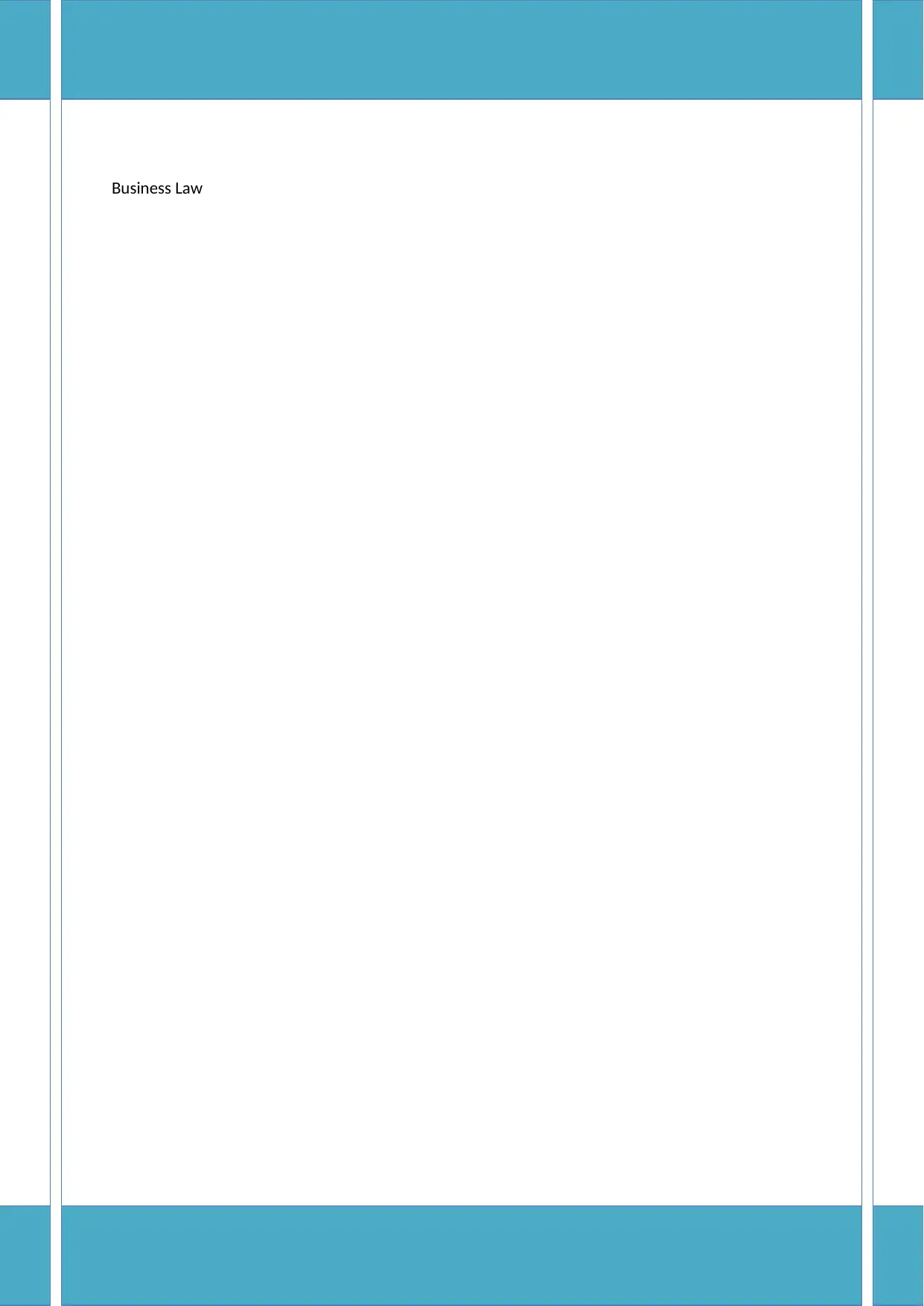
Business Law
Paraphrase This Document
Need a fresh take? Get an instant paraphrase of this document with our AI Paraphraser
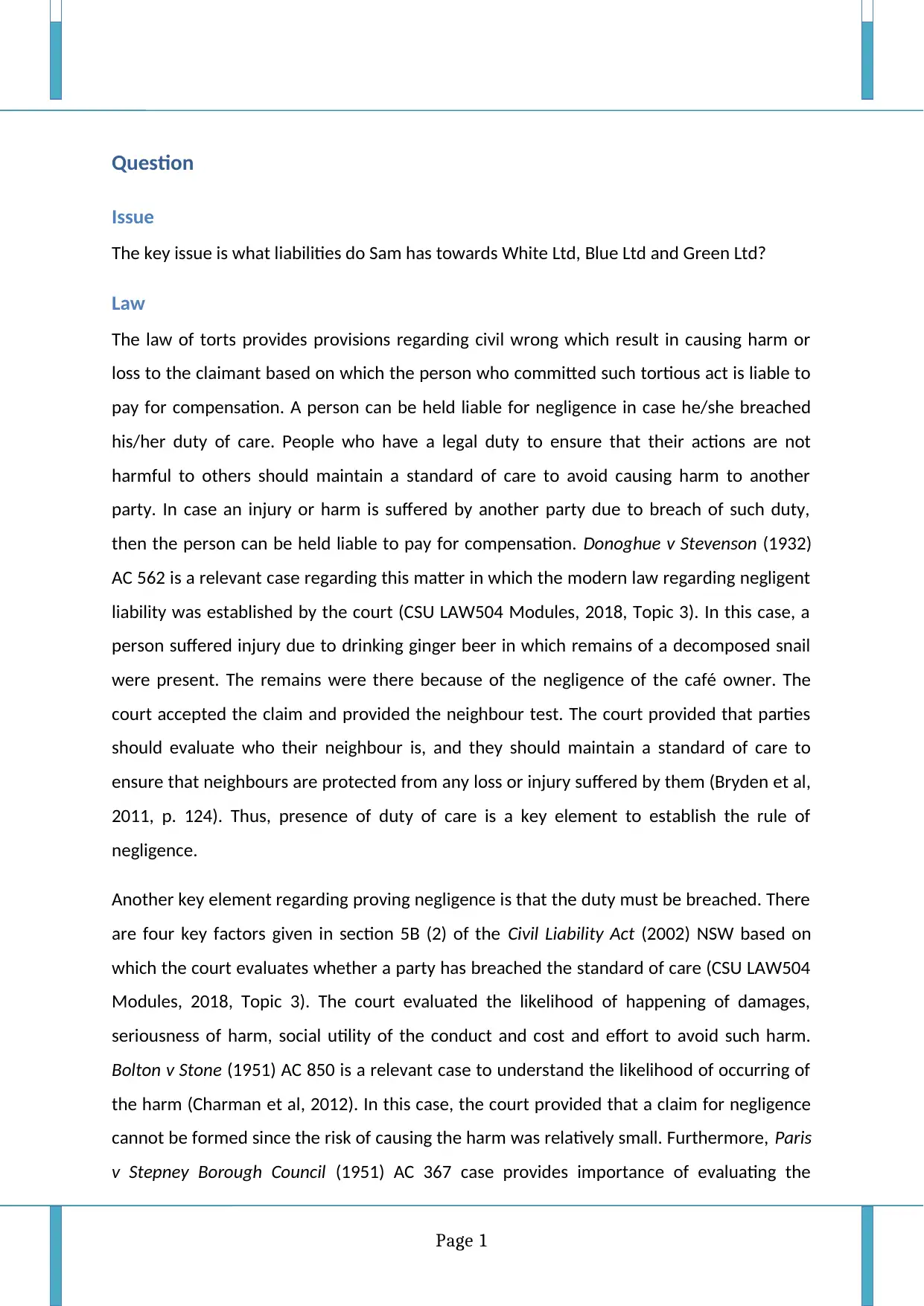
Question
Issue
The key issue is what liabilities do Sam has towards White Ltd, Blue Ltd and Green Ltd?
Law
The law of torts provides provisions regarding civil wrong which result in causing harm or
loss to the claimant based on which the person who committed such tortious act is liable to
pay for compensation. A person can be held liable for negligence in case he/she breached
his/her duty of care. People who have a legal duty to ensure that their actions are not
harmful to others should maintain a standard of care to avoid causing harm to another
party. In case an injury or harm is suffered by another party due to breach of such duty,
then the person can be held liable to pay for compensation. Donoghue v Stevenson (1932)
AC 562 is a relevant case regarding this matter in which the modern law regarding negligent
liability was established by the court (CSU LAW504 Modules, 2018, Topic 3). In this case, a
person suffered injury due to drinking ginger beer in which remains of a decomposed snail
were present. The remains were there because of the negligence of the café owner. The
court accepted the claim and provided the neighbour test. The court provided that parties
should evaluate who their neighbour is, and they should maintain a standard of care to
ensure that neighbours are protected from any loss or injury suffered by them (Bryden et al,
2011, p. 124). Thus, presence of duty of care is a key element to establish the rule of
negligence.
Another key element regarding proving negligence is that the duty must be breached. There
are four key factors given in section 5B (2) of the Civil Liability Act (2002) NSW based on
which the court evaluates whether a party has breached the standard of care (CSU LAW504
Modules, 2018, Topic 3). The court evaluated the likelihood of happening of damages,
seriousness of harm, social utility of the conduct and cost and effort to avoid such harm.
Bolton v Stone (1951) AC 850 is a relevant case to understand the likelihood of occurring of
the harm (Charman et al, 2012). In this case, the court provided that a claim for negligence
cannot be formed since the risk of causing the harm was relatively small. Furthermore, Paris
v Stepney Borough Council (1951) AC 367 case provides importance of evaluating the
Page 1
Issue
The key issue is what liabilities do Sam has towards White Ltd, Blue Ltd and Green Ltd?
Law
The law of torts provides provisions regarding civil wrong which result in causing harm or
loss to the claimant based on which the person who committed such tortious act is liable to
pay for compensation. A person can be held liable for negligence in case he/she breached
his/her duty of care. People who have a legal duty to ensure that their actions are not
harmful to others should maintain a standard of care to avoid causing harm to another
party. In case an injury or harm is suffered by another party due to breach of such duty,
then the person can be held liable to pay for compensation. Donoghue v Stevenson (1932)
AC 562 is a relevant case regarding this matter in which the modern law regarding negligent
liability was established by the court (CSU LAW504 Modules, 2018, Topic 3). In this case, a
person suffered injury due to drinking ginger beer in which remains of a decomposed snail
were present. The remains were there because of the negligence of the café owner. The
court accepted the claim and provided the neighbour test. The court provided that parties
should evaluate who their neighbour is, and they should maintain a standard of care to
ensure that neighbours are protected from any loss or injury suffered by them (Bryden et al,
2011, p. 124). Thus, presence of duty of care is a key element to establish the rule of
negligence.
Another key element regarding proving negligence is that the duty must be breached. There
are four key factors given in section 5B (2) of the Civil Liability Act (2002) NSW based on
which the court evaluates whether a party has breached the standard of care (CSU LAW504
Modules, 2018, Topic 3). The court evaluated the likelihood of happening of damages,
seriousness of harm, social utility of the conduct and cost and effort to avoid such harm.
Bolton v Stone (1951) AC 850 is a relevant case to understand the likelihood of occurring of
the harm (Charman et al, 2012). In this case, the court provided that a claim for negligence
cannot be formed since the risk of causing the harm was relatively small. Furthermore, Paris
v Stepney Borough Council (1951) AC 367 case provides importance of evaluating the
Page 1
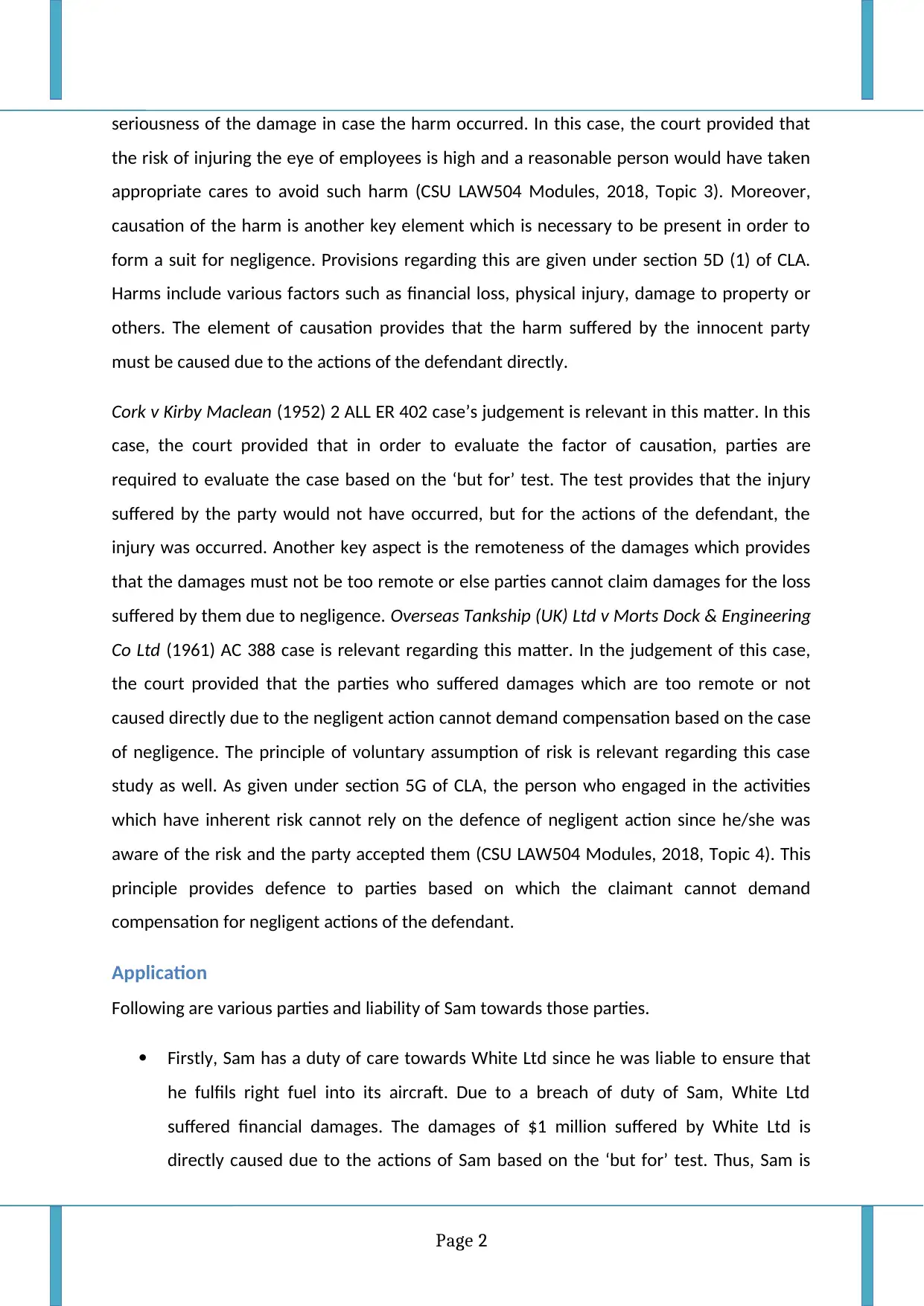
seriousness of the damage in case the harm occurred. In this case, the court provided that
the risk of injuring the eye of employees is high and a reasonable person would have taken
appropriate cares to avoid such harm (CSU LAW504 Modules, 2018, Topic 3). Moreover,
causation of the harm is another key element which is necessary to be present in order to
form a suit for negligence. Provisions regarding this are given under section 5D (1) of CLA.
Harms include various factors such as financial loss, physical injury, damage to property or
others. The element of causation provides that the harm suffered by the innocent party
must be caused due to the actions of the defendant directly.
Cork v Kirby Maclean (1952) 2 ALL ER 402 case’s judgement is relevant in this matter. In this
case, the court provided that in order to evaluate the factor of causation, parties are
required to evaluate the case based on the ‘but for’ test. The test provides that the injury
suffered by the party would not have occurred, but for the actions of the defendant, the
injury was occurred. Another key aspect is the remoteness of the damages which provides
that the damages must not be too remote or else parties cannot claim damages for the loss
suffered by them due to negligence. Overseas Tankship (UK) Ltd v Morts Dock & Engineering
Co Ltd (1961) AC 388 case is relevant regarding this matter. In the judgement of this case,
the court provided that the parties who suffered damages which are too remote or not
caused directly due to the negligent action cannot demand compensation based on the case
of negligence. The principle of voluntary assumption of risk is relevant regarding this case
study as well. As given under section 5G of CLA, the person who engaged in the activities
which have inherent risk cannot rely on the defence of negligent action since he/she was
aware of the risk and the party accepted them (CSU LAW504 Modules, 2018, Topic 4). This
principle provides defence to parties based on which the claimant cannot demand
compensation for negligent actions of the defendant.
Application
Following are various parties and liability of Sam towards those parties.
Firstly, Sam has a duty of care towards White Ltd since he was liable to ensure that
he fulfils right fuel into its aircraft. Due to a breach of duty of Sam, White Ltd
suffered financial damages. The damages of $1 million suffered by White Ltd is
directly caused due to the actions of Sam based on the ‘but for’ test. Thus, Sam is
Page 2
the risk of injuring the eye of employees is high and a reasonable person would have taken
appropriate cares to avoid such harm (CSU LAW504 Modules, 2018, Topic 3). Moreover,
causation of the harm is another key element which is necessary to be present in order to
form a suit for negligence. Provisions regarding this are given under section 5D (1) of CLA.
Harms include various factors such as financial loss, physical injury, damage to property or
others. The element of causation provides that the harm suffered by the innocent party
must be caused due to the actions of the defendant directly.
Cork v Kirby Maclean (1952) 2 ALL ER 402 case’s judgement is relevant in this matter. In this
case, the court provided that in order to evaluate the factor of causation, parties are
required to evaluate the case based on the ‘but for’ test. The test provides that the injury
suffered by the party would not have occurred, but for the actions of the defendant, the
injury was occurred. Another key aspect is the remoteness of the damages which provides
that the damages must not be too remote or else parties cannot claim damages for the loss
suffered by them due to negligence. Overseas Tankship (UK) Ltd v Morts Dock & Engineering
Co Ltd (1961) AC 388 case is relevant regarding this matter. In the judgement of this case,
the court provided that the parties who suffered damages which are too remote or not
caused directly due to the negligent action cannot demand compensation based on the case
of negligence. The principle of voluntary assumption of risk is relevant regarding this case
study as well. As given under section 5G of CLA, the person who engaged in the activities
which have inherent risk cannot rely on the defence of negligent action since he/she was
aware of the risk and the party accepted them (CSU LAW504 Modules, 2018, Topic 4). This
principle provides defence to parties based on which the claimant cannot demand
compensation for negligent actions of the defendant.
Application
Following are various parties and liability of Sam towards those parties.
Firstly, Sam has a duty of care towards White Ltd since he was liable to ensure that
he fulfils right fuel into its aircraft. Due to a breach of duty of Sam, White Ltd
suffered financial damages. The damages of $1 million suffered by White Ltd is
directly caused due to the actions of Sam based on the ‘but for’ test. Thus, Sam is
Page 2
⊘ This is a preview!⊘
Do you want full access?
Subscribe today to unlock all pages.

Trusted by 1+ million students worldwide
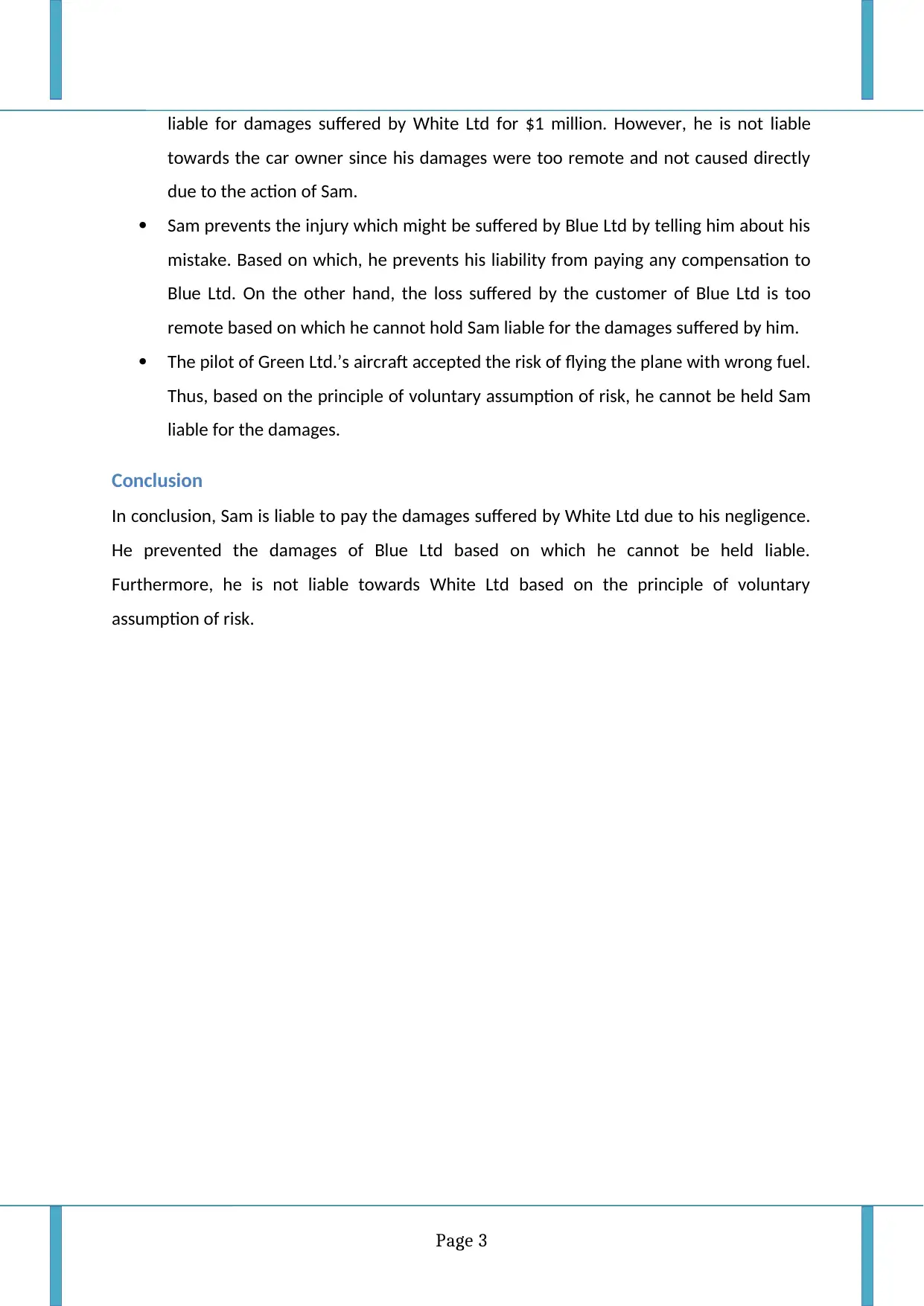
liable for damages suffered by White Ltd for $1 million. However, he is not liable
towards the car owner since his damages were too remote and not caused directly
due to the action of Sam.
Sam prevents the injury which might be suffered by Blue Ltd by telling him about his
mistake. Based on which, he prevents his liability from paying any compensation to
Blue Ltd. On the other hand, the loss suffered by the customer of Blue Ltd is too
remote based on which he cannot hold Sam liable for the damages suffered by him.
The pilot of Green Ltd.’s aircraft accepted the risk of flying the plane with wrong fuel.
Thus, based on the principle of voluntary assumption of risk, he cannot be held Sam
liable for the damages.
Conclusion
In conclusion, Sam is liable to pay the damages suffered by White Ltd due to his negligence.
He prevented the damages of Blue Ltd based on which he cannot be held liable.
Furthermore, he is not liable towards White Ltd based on the principle of voluntary
assumption of risk.
Page 3
towards the car owner since his damages were too remote and not caused directly
due to the action of Sam.
Sam prevents the injury which might be suffered by Blue Ltd by telling him about his
mistake. Based on which, he prevents his liability from paying any compensation to
Blue Ltd. On the other hand, the loss suffered by the customer of Blue Ltd is too
remote based on which he cannot hold Sam liable for the damages suffered by him.
The pilot of Green Ltd.’s aircraft accepted the risk of flying the plane with wrong fuel.
Thus, based on the principle of voluntary assumption of risk, he cannot be held Sam
liable for the damages.
Conclusion
In conclusion, Sam is liable to pay the damages suffered by White Ltd due to his negligence.
He prevented the damages of Blue Ltd based on which he cannot be held liable.
Furthermore, he is not liable towards White Ltd based on the principle of voluntary
assumption of risk.
Page 3
Paraphrase This Document
Need a fresh take? Get an instant paraphrase of this document with our AI Paraphraser
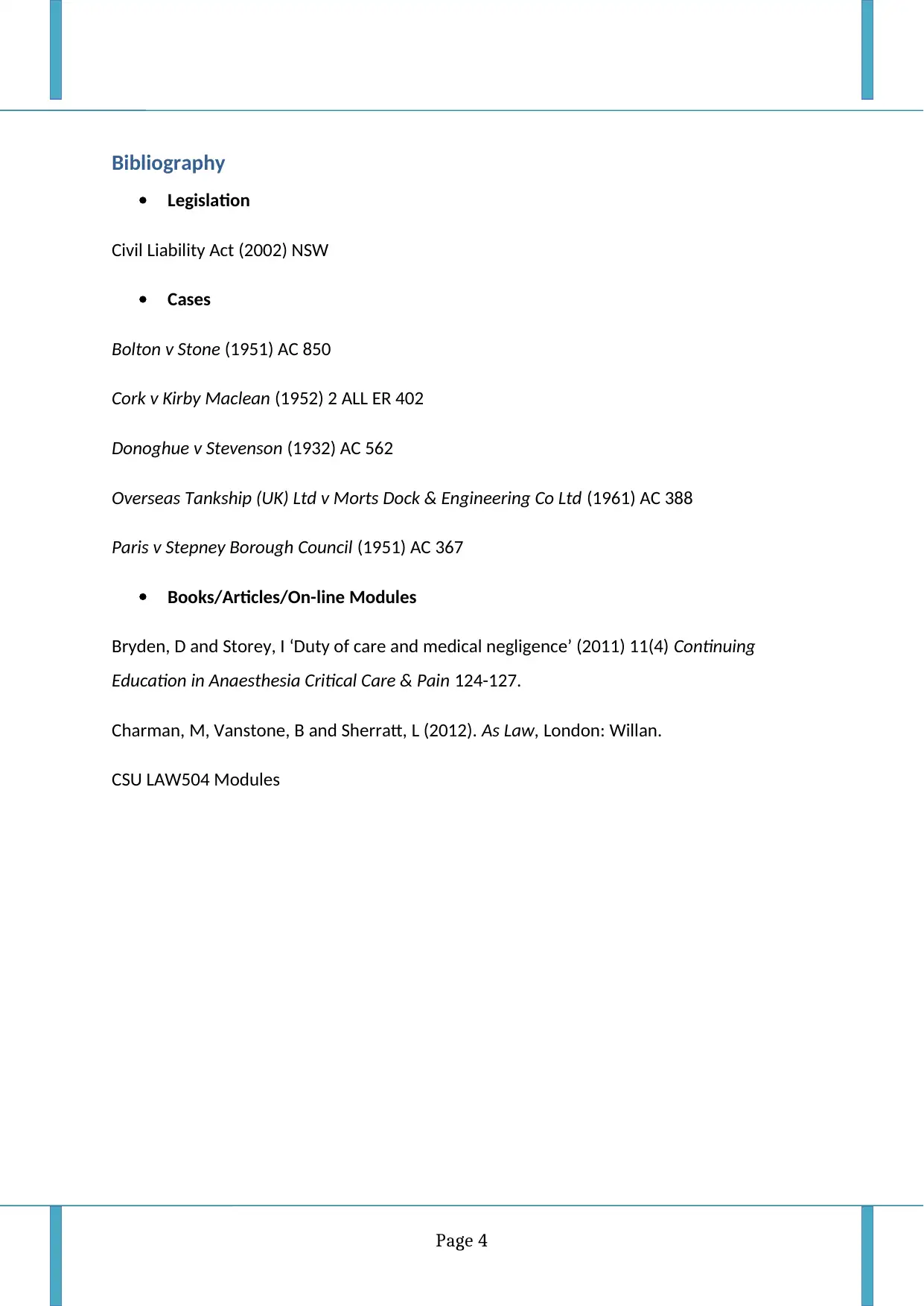
Bibliography
Legislation
Civil Liability Act (2002) NSW
Cases
Bolton v Stone (1951) AC 850
Cork v Kirby Maclean (1952) 2 ALL ER 402
Donoghue v Stevenson (1932) AC 562
Overseas Tankship (UK) Ltd v Morts Dock & Engineering Co Ltd (1961) AC 388
Paris v Stepney Borough Council (1951) AC 367
Books/Articles/On-line Modules
Bryden, D and Storey, I ‘Duty of care and medical negligence’ (2011) 11(4) Continuing
Education in Anaesthesia Critical Care & Pain 124-127.
Charman, M, Vanstone, B and Sherratt, L (2012). As Law, London: Willan.
CSU LAW504 Modules
Page 4
Legislation
Civil Liability Act (2002) NSW
Cases
Bolton v Stone (1951) AC 850
Cork v Kirby Maclean (1952) 2 ALL ER 402
Donoghue v Stevenson (1932) AC 562
Overseas Tankship (UK) Ltd v Morts Dock & Engineering Co Ltd (1961) AC 388
Paris v Stepney Borough Council (1951) AC 367
Books/Articles/On-line Modules
Bryden, D and Storey, I ‘Duty of care and medical negligence’ (2011) 11(4) Continuing
Education in Anaesthesia Critical Care & Pain 124-127.
Charman, M, Vanstone, B and Sherratt, L (2012). As Law, London: Willan.
CSU LAW504 Modules
Page 4
1 out of 5
Related Documents
Your All-in-One AI-Powered Toolkit for Academic Success.
+13062052269
info@desklib.com
Available 24*7 on WhatsApp / Email
![[object Object]](/_next/static/media/star-bottom.7253800d.svg)
Unlock your academic potential
Copyright © 2020–2025 A2Z Services. All Rights Reserved. Developed and managed by ZUCOL.





